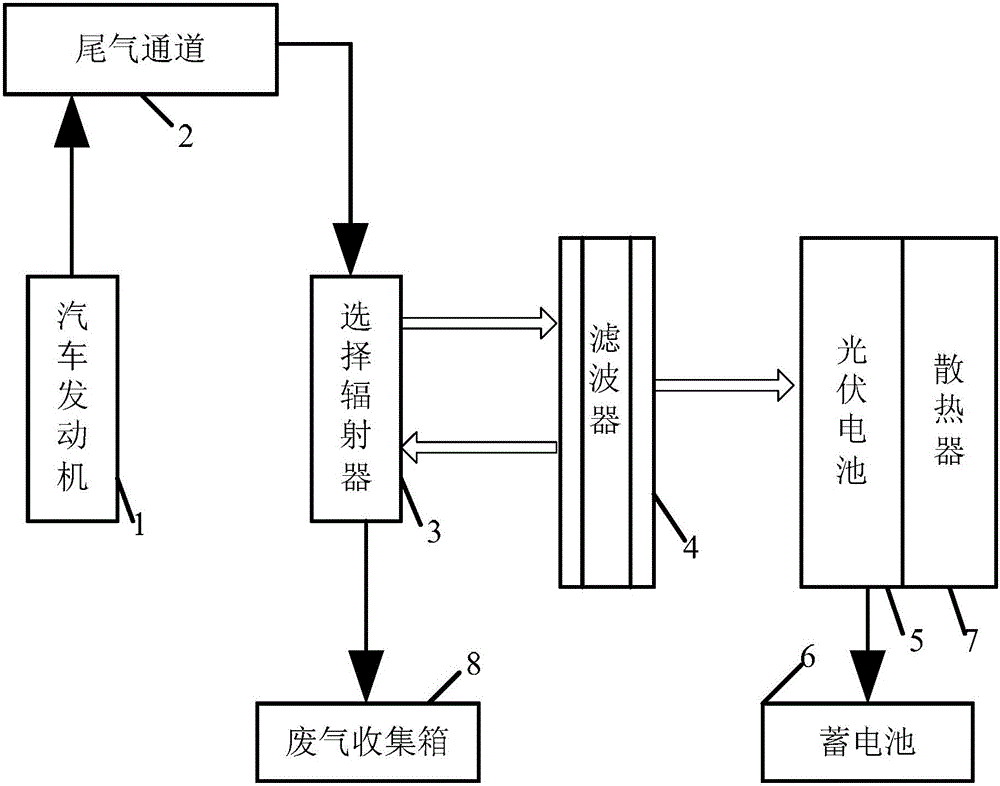Thermal Photovoltaic System Based on Exhaust Heat from Vehicle Exhaust
An automobile exhaust and thermal photovoltaic technology, which is applied in photovoltaic power generation, photovoltaic modules, photovoltaic power stations, etc., can solve the problems of low fuel utilization rate of automobiles, and achieve the effect of solving the problem of thermal pollution and improving the utilization efficiency.
- Summary
- Abstract
- Description
- Claims
- Application Information
AI Technical Summary
Problems solved by technology
Method used
Image
Examples
specific Embodiment approach 1
[0014] Specific embodiment one: reference figure 1 To describe this embodiment in detail, the thermal photovoltaic system based on the waste heat of automobile exhaust gas described in this embodiment includes: exhaust gas channel 2, selective radiator 3, filter 4 and photovoltaic cell 5;
[0015] The exhaust end of the exhaust channel 2 is connected to the intake end of the selective radiator 3. The filter 4 is used to filter the infrared radiation waves it receives and send useful radiation energy to the photovoltaic cell 5, which is used to transmit it The received useful radiation energy is converted into electrical energy.
specific Embodiment approach 2
[0016] Embodiment 2: This embodiment is a further description of the thermal photovoltaic system based on the waste heat of automobile exhaust as described in Embodiment 1. In this embodiment, it also includes: automobile engine 1, battery 6, radiator 7 and exhaust gas Collection box 8.
[0017] The exhaust end of the automobile engine 1 is connected to the intake end of the exhaust channel 2, the power output end of the photovoltaic cell 5 is connected to the power input end of the battery 6, the radiator 7 is used to dissipate heat for the photovoltaic cell 5, and the intake end of the exhaust gas collection box 8 Connect the outlet end of the selective radiator 3.
specific Embodiment approach 3
[0018] Specific embodiment three: This embodiment is a further description of the thermal photovoltaic system based on the waste heat of automobile exhaust as described in specific embodiment one or two. In this embodiment, the material of the radiator 3 is selected as the high temperature heat of 800K~1200K. In the radiation equilibrium state, the emission spectrum peak is located at 3.5 microns, the emission peak width is less than 0.5 microns, and the composite material has monochromaticity.
PUM
 Login to view more
Login to view more Abstract
Description
Claims
Application Information
 Login to view more
Login to view more - R&D Engineer
- R&D Manager
- IP Professional
- Industry Leading Data Capabilities
- Powerful AI technology
- Patent DNA Extraction
Browse by: Latest US Patents, China's latest patents, Technical Efficacy Thesaurus, Application Domain, Technology Topic.
© 2024 PatSnap. All rights reserved.Legal|Privacy policy|Modern Slavery Act Transparency Statement|Sitemap

